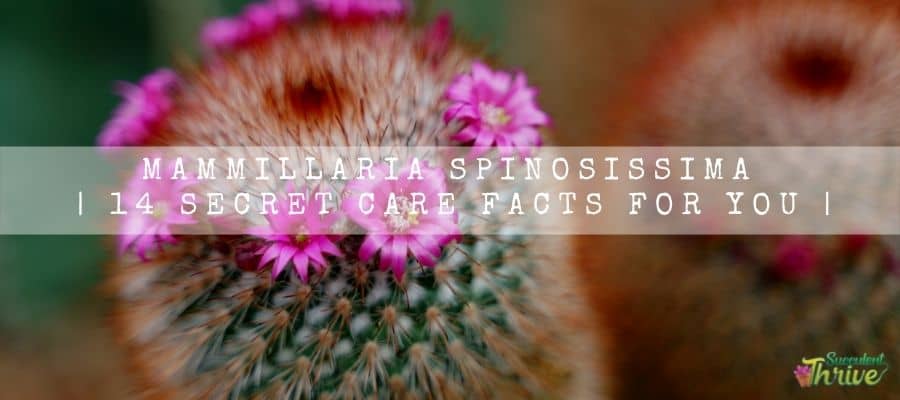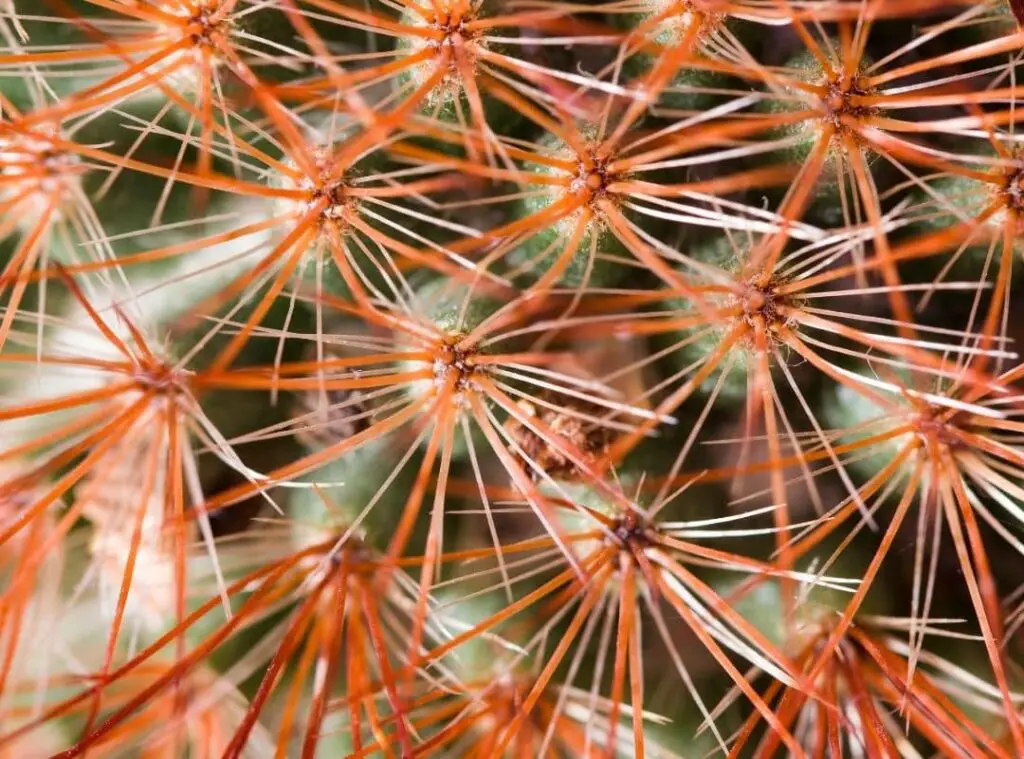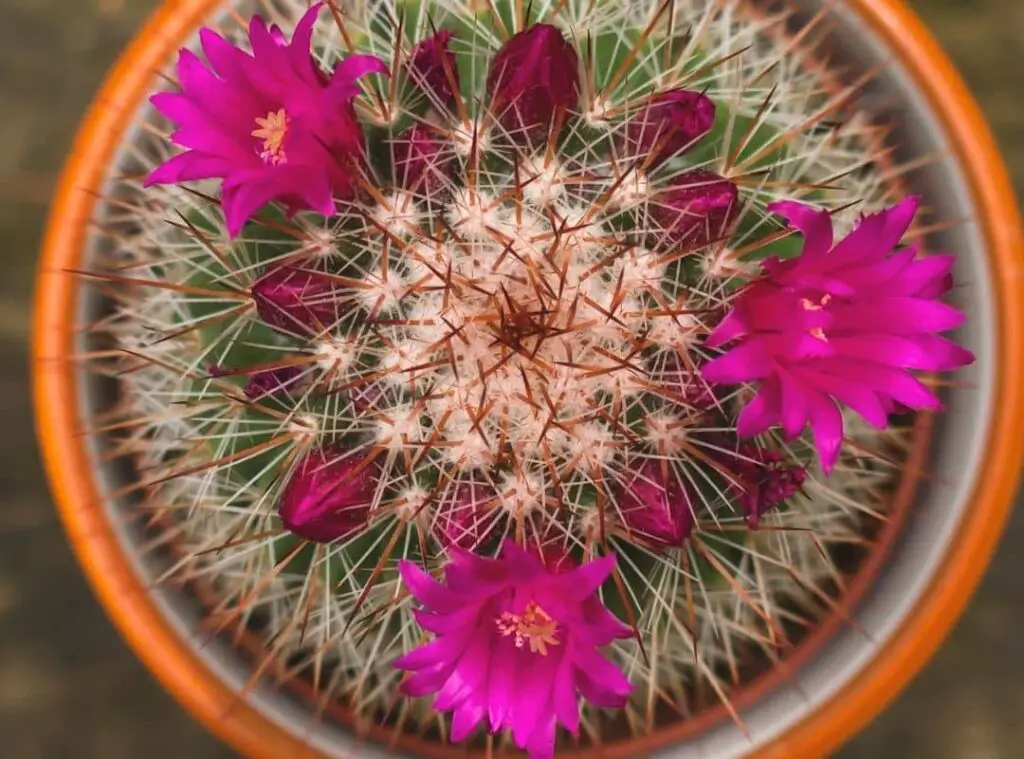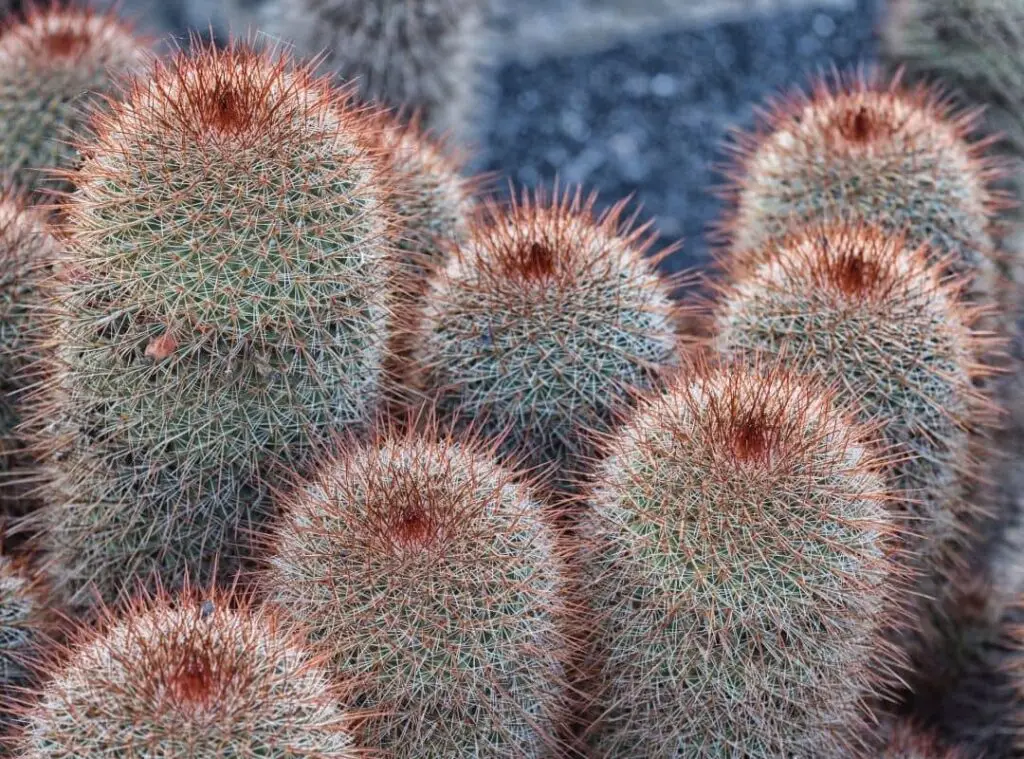Mammillaria spinosissima is a fantastic and easy to care plant find in the succulent world.
Mammillaria spinosissima belong to the Mammillaria genus and they are native plants to Central Mexico. Red-headed Irishman is what you could call these plants
This is a fabulous evergreen plant and if you are excited to discover Mammillaria spinosissima plants, keep reading this article as I am going to touch on their growing tips, propagation methods as well as their common pests’ issues as well.

How do I identify Mammillaria spinosissima?
It comprises a columnar body which can reach up to 30 cm in height. Further they could grow to 10 cm widespread too.
Mammillaria spinosissima could grow as either solitary plants or in colonies. Mammillaria spinosissima tubers are wooly in the armpits and dark blue-green in color.
Further they would consist of areolas which tend to take a circular shape. In addition to that they would consist of about 20-30 radial spines as well.
Those radial spines would be white in color and 1 cm in length. Not only that but also Mammillaria spinosissima consists of central spines as well.
They will be red in color and there will be about 7-15 central spines of the plants. It is an evergreen plant and their flowering activity would also be useful in identifying the plants.
They would in fact produce flowers in pink, purple or in red. They are tiny blooms, and they would arise at the plant top crown.
Size of the plant
They would reach a maximum height of 30 cm. Moreover, they would be about 10 cm wide too.
Growth rate
They generally grows at a moderate rate. They grow in an erect manner.
One look care guide
| Botanical Name | Mammillaria spinosissima |
| Common Name | Red Headed Irishman |
| Plant Type | cacti |
| Mature Size | Maximum height of 30 cm / 10 cm widespread |
| Sun Exposure | Full sunlight to partial sunlight |
| Soil Type | Sandy, loamy and well-draining |
| Soil pH | acid, alkaline or neutral. |
| Bloom Time | Spring summer |
| Flower Color | Red Pink purple |
| Hardiness Zones | USDA hardiness zones 9a-11b |
| Native Area | Mexico |
| Toxicity | Non Toxic |
| Average price | USD 8 |
How do you take care of Mammillaria spinosissima?
To briefly touch on the plant’s care treatments, they would require warmer temperatures, partial sunlight to full sunlight.
They could survive with minimum water. Growing them outdoors would be ideal rather than growing them indoors. Having said that, they could perform well even if you grow them indoors as well.
Light Requirement
Mammillaria spinosissima could do well given that you supply them with full sunlight, preferably in the morning hours.
They could withstand partial shade during afternoon hours particularly during intense summer conditions.
It is important that you expose them to bright sunlight at least for a few hours since it is crucial for the plant’s vigorous growth and for the wellbeing as well.
Be careful not to leave them under the scorching sun as it could create a bad impact on the plant by creating sunburns in the plants.
Temperature and humidity
Mammillaria spinosissima could tolerate a minimum temperature of 8 degrees Celsius ( 48 degrees Fahrenheit ).
Having said that they would prefer to grow in a temperature range of 22-24 degrees Celsius (71-75 degrees Celsius).
Excess humidity levels is something which you need to avoid when growing these beautiful plants as they do not prefer to be in such conditions.

Is it cold hardy?
Mammillaria spinosissima are mildly cold hardy plants.
USDA Hardiness Zone
Mammillaria spinosissima prefers to grow in USDA hardiness zones 9a-11b.
Watering Requirement
Mammillaria spinosissima requires only a minimum amount of water just like the rest of other succulents and cacti.
If you are into succulent gardening, I am sure that you know, you need to water these plants only if their soil is dry and Mammillaria spinosissima is no different to them.
Mammillaria spinosissima adapted to grow in drought conditions, hence they could thrive well with limited water.
Avoid supplying them with an abundance of water as it could create repercussions such as root rot.
I encourage you to suspend watering the Mammillaria spinosissima from mid fall to early spring. Mammillaria spinosissima go into their relaxing mode from mid fall to early spring.
That is when you call them, they are in their dormancy period. Mammillaria spinosissima do not require any water when they are dormant.
Having said that if you spot their soil is bone dry, you could consider misting them lightly.
Something very important to keep in mind is that, if you end up supplying them too much water, over-watering could easily take place during winter times.
That could be sometimes even lethal on the Mammillaria spinosissima succulent care plants.
Soil Requirement Type / pH
You could grow the Mammillaria spinosissima plants in a sandy and a loamy soil mix which is well draining.
You could easily go ahead with planting them in a commercial cactus potting medium which is available at garden stores.
Ensure that you go ahead with a cactus soil mix which consists of at least 20 % of coarse sand. When it comes to the right pH of the soil mix, it needs to be ideally acid, alkaline or neutral.
Flowering and Fragrance
Mammillaria spinosissima flowers would be either pink, purple or red. They are small in size and would usually arise in the plant crowns during spring and in summer.

Pot size Potting and Repotting
Mammillaria spinosissima would thrive well if you have grown them in a porous material pot such as in clay or in terracotta pots.
The purpose of using these materials is that they could evaporate the excess moisture faster. When it comes to repotting, you could consider repotting them periodically and if it is essential only.
However, the best season to conduct reporting is either spring or summer as they are the active growing seasons.
There are advantages of repotting as it would help you to closely look at the plants and you could spot if there are any rotten or damaged roots.
If you find any, you could treat them with fungicides.
In addition to that once you repot them in a fresh soil mix, it will allow the plants to absorb nutrients freshly and consequently it would stimulate the growth of the plants as well.
Before you proceed with repotting, you need to make sure that the plant is dry so that you can easily remove the plant from the pot.
Once you repot them, cease watering them for about one week’s time and only after that resume watering them.
Where to Plant
If you grow them as houseplants, ensure that you grow them in a succulent or cactus soil mix which has an excellent drainage.
If you wish to fasten the drainage of the soil mix further, you could consider adding perlite or pumice. When blending them, ensure that you mix them with a 1:1:1 ratio along with cactus mix.
Apart from that, ensure that you locate them in a place where they can gain full sunlight to partial sunlight.
Due to this, outdoor conditions would suit them the best and it will help the Mammillaria spinosissima plants to perform very well.
If you are experiencing intense hotter climates, you need to shift them to a shady place for a shorter period. When the conditions get better, you could shift them back to where they were before.
You could grow the Mammillaria spinosissima as indoor plants too. However, ensure that you fulfill its light requirement though.
Mammillaria spinosissima are mild cold hardy plants. However , if an extreme winter condition is predicted, you need to bring them indoors and protect the plants from those unhealthy conditions.
Fertilizer and time of year
You could consider feeding the Mammillaria spinosissima with a cactus fertilizer mix. However, ensure that you dilute it to half strength and then use.
Generally, you could feed them once every two months. You need to adjust the frequency in feeding them depending on the fertilizer you use.
However, keep in mind to suspend feeding them during dormancy. Best season to feed them is spring and summer.

Dormancy
Mammillaria spinosissima could go dormant in extreme winter conditions.
Can be toxic to pets
Mammillaria spinosissima are not toxic for pets and for humans as well.
Common bugs and illnesses
Mammillaria spinosissima could resist diseases in general. Having said that pests such as mealy bugs, prime mites could attack these plants.
Apart from these pests, Mammillaria spinosissima would suffer from root rot if you do not water them properly.
Special Care tips
Mammillaria spinosissima can survive on their own and they do not require any special attention from you as long as you fulfil their necessities.
How to propagate Mammillaria spinosissima
You could use the Mammillaria spinosissima seeds to propagate them. You need to conduct propagation in spring.
You simply have to sow them in a sandy soil mix. Alternatively, you could consider separating the suckers as well.
Mammillaria spinosissima plant benefits
- Mammillaria spinosissima would be handy to use for pots which you could place indoors.
- In addition to that you could consider growing them in a greenhouse, balconies and even on your terraces as well.
- Apart from that, Mammillaria spinosissima would be a great pick for rockeries, dry slopes as well.
- Finally, you could grow them in cactus and succulent gardens as well.
Conclusion
To sum up, Mammillaria spinosissima succulents would be such great additions to your indoor garden collection as well as for your outdoor garden collection.
So start gardening them soon and get that experience and enjoy.
Read Next Mammillaria Herrerae | 14 Care Secrets Nobody Told You | Mammillaria Bombycina Succulent Care | 14 Secrets You Never Knew | Mammillaria Microthele Care | 15 Facts You Must Consider | Mammillaria luethyi | 15 Care Tips For A Healthy Plant |
